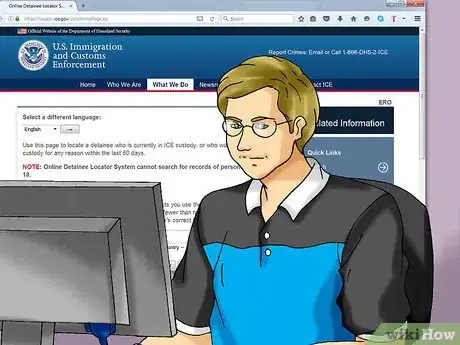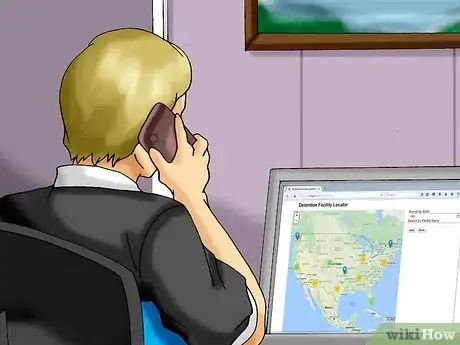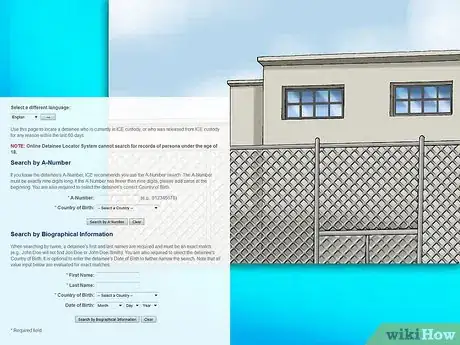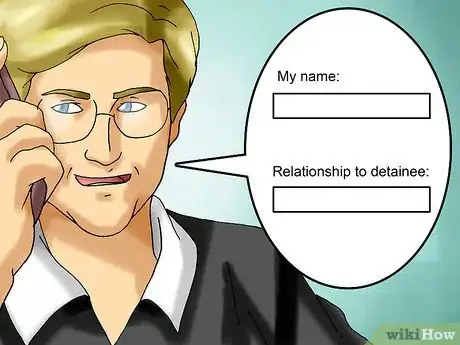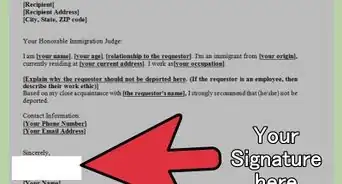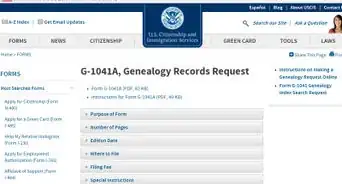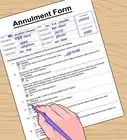This article was written by Jennifer Mueller, JD. Jennifer Mueller is an in-house legal expert at wikiHow. Jennifer reviews, fact-checks, and evaluates wikiHow's legal content to ensure thoroughness and accuracy. She received her JD from Indiana University Maurer School of Law in 2006.
This article has been viewed 100,096 times.
The Department of Homeland Security (DHS) detains immigrants who are undocumented or removable for other reasons, using Immigration and Customs Enforcement (ICE) detention facilities as well as state and local jails and correctional facilities. Detention ensures the immigrant will show up for deportation proceedings before the Immigration Court. However, deportation proceedings can take months or even years, so if you know someone who has been detained, you should act as quickly as possible to locate him or her so you can work for his or her release.[1]
Steps
Locating a Detainee
-
1Use the ICE Online Detainee Locator System. ICE has a webpage you can use to search detainees in their custody and find out where they are being held.[2] [3]
- To use the system, go to https://locator.ice.gov/odls/homePage.do.
- You can search for a detainee using his or her A-Number (the nine-digit Alien Number assigned to the person, usually found on his or her green card or work permit) if you have such a document available. You also must enter the person's home country.
- If you don't have the detainee's A-Number, you can search by entering his or her first and last name, country, and date of birth.
- Name and home country are required, and must match ICE's records exactly – meaning you may have to try several alternate spellings of the person's name to find him or her. Entering a date of birth is optional, but can help narrow your search.
- Keep in mind you can only use this service to find detainees over the age of 18.
-
2Call the facility to verify the detainee's presence there. Given the time it can take to update the online system, call and make sure the detainee hasn't been transferred.
- The system typically is updated within a few hours after a detainee has arrived at a new location, if he or she has been transferred.[4]
- You can find a list of ICE detention facilities and contact information at https://www.ice.gov/detention-facilities.
- ICE typically won't transfer detainees if they have immediate family, such as parents or children, who live near the facility. However, it's important to make your presence known as quickly as possible if ICE isn't already aware of family in the area if you want to avoid the risk of transfer.
- Keep in mind that detainees can be transferred quickly and without warning, or even removed from the country within a matter of days after being detained.[5]
Advertisement -
3Check nearby jails or correctional facilities. If the detainee doesn't show up in the ICE system, he or she may be housed in a local jail rather than an ICE facility.[6]
- The ICE online system only has records of detainees housed in ICE immigrant detention facilities.
- If the person has been charged with a crime, he or she typically will be held in a correctional facility rather than an immigration detention center.
- The federal prison system and most state correctional institutions also have online search capabilities. Do an internet search for "inmate search" with the name of the state or county where the detainee was last seen.
-
4Contact the nearest ICE field office. The field office can help you find detainees who have only recently been detained or whose information isn't available in the online system.[7]
- You can find contact information for all ICE Enforcement and Removal Operations Field Offices online at https://www.ice.gov/contact/ero.
- When you call the field office, tell the agent who answers the phone that you are seeking information about a detainee. Give the agent the detainee's name. He or she will provide you the information or direct you to someone who can better assist you.
Talking to the Deportation Officer
-
1Find out the name and location of the detainee's deportation officer. When you call the ICE field office, ask if you can speak to the deportation officer that was assigned the detainee's case.[8]
- The deportation officer is in charge of the detainee's well-being while he or she is in immigration custody, as well as administering his or her immigration case.
- If the deportation officer won't take your calls, you may need to work with an immigration officer to open those lines of communication so you can help the detainee with his or her case.
-
2Explain who you are. You will need to tell the deportation officer your name and your relationship to the detainee.[9]
- The deportation officer likely will be more willing to talk to you or give you information about the detainee if you are a close relative.
- Be careful when speaking to the deportation officer. Remember that anything you say can potentially be used against the detainee in his or her immigration proceedings, so avoid making any statements about the detainee's immigration status or activities he or she is involved in.
-
3Ask how you can visit the detainee. The deportation officer can provide you information about how and when you can arrange a visitation.[10]
- If the detainee requires regular medical care, you should let the deportation officer know so he or she can make arrangements.
- The deportation officer will let you know how you can visit the detainee, whether you can bring items the detainee might need, and what sorts of items are permitted.
-
4Find out what relief options are available for the detainee. Deportation officers have the authority to offer certain forms of release such as voluntary departure.[11]
- While it's important to know what options are on the table, make sure you evaluate each available form of relief carefully before you make any decisions, and don't commit to a plan of action without discussing the matter with the detainee.
- Depending on the forms of relief available, you may want to consult an immigration attorney to understand what those options might mean for the detainee's future ability to enter the U.S. or seek permanent residency or citizenship.
Getting a Detainee Out of Detention
-
1Determine whether bond has been set. ICE may have set a bond, similar to bail in an ordinary criminal court, that must be paid before the detainee can be released.[12]
- You can ask the deportation officer about the detainee's bond. If the officer tells you the detainee doesn't have a bond, you need to find out if this is because the detainee isn't eligible for a bond or because the bond hasn't been set.
- The minimum bond is $1,500, but depending on the circumstances, it may be $20,000 or more. A higher bond indicates ICE believes the detainee to be a substantial flight risk. Bonds also may be higher if the detainee has a criminal record or no significant ties to the area.[13]
- Just as with bail in criminal court, the bond guarantees the detainee's appearance in court. If the detainee fails to appear, the person who paid the bond forfeits the money. However, you will get your money back provided the detainee shows up for all scheduled hearings.[14]
- If the detainee has a prior removal order, or has a record of committing certain crimes such as violent felonies, drug offenses, or terrorism-related offenses, the law mandates detention and he or she cannot be released before removal proceedings are completed.[15]
-
2Request a bond hearing. If bond has not been set, or if you believe the amount of the bond is excessive, you can file a motion for a bond hearing.[16]
- Every detainee is entitled to a bond hearing, but you don't have to wait until the detainee's first hearing to have bond determined.
- You also should consider asking for a bond hearing if you can't afford to pay the bond. A judge may lower the amount, particularly if you are a close relative with strong ties to the area who can vouch for the detainee's appearance at his or her hearings.
- Often a judge will set bond at the detainee's initial hearing – but you can request an earlier hearing simply to determine the amount of the bond. To request this hearing, you must file a document called "Motion for Bond Redetermination" with the Immigration Court on behalf of the detainee.[17]
- If you need to file a motion, you definitely should consider hiring an experienced immigration attorney to assist you. If you're concerned about the expense, you can check with the nearest legal aid office or call a nonprofit immigration organization for connections to free or reduced-fee legal assistance.
-
3Arrange to pay the bond. The detainee will only be released if the set bond is paid.[18] [19]
- Keep in mind that you must have legal status in the U.S. to pay a detainee's bond. In other words, you must be a citizen or lawful permanent resident.
- You must pay the bond at your nearest ICE field office using a cashier's check made out to "Department of Homeland Security." They won't take cash, credit cards, or personal checks.
- You must bring your Social Security card and a government-issued photo ID with you when you pay the bond.
- You also must have the detainee's name, date of birth, and A-Number so the bond can be applied to the right person.
- Because many detention centers will not arrange for the transportation of a detainee upon release, you should make arrangements to pick up the detainee at the detention center when he or she is released.[20]
References
- ↑ http://www.nolo.com/legal-encyclopedia/immigration-detention-101-information-detainees-family-friends.html
- ↑ https://locator.ice.gov/odls/homePage.do
- ↑ http://www.nolo.com/legal-encyclopedia/immigration-detention-101-information-detainees-family-friends.html
- ↑ http://www.apsanlaw.com/law-109.ice-online-detainee-locator-system.html
- ↑ http://www.nolo.com/legal-encyclopedia/immigration-detention-101-information-detainees-family-friends.html
- ↑ http://www.nolo.com/legal-encyclopedia/immigration-detention-101-information-detainees-family-friends.html
- ↑ http://www.nolo.com/legal-encyclopedia/immigration-detention-101-information-detainees-family-friends.html
- ↑ http://www.nolo.com/legal-encyclopedia/immigration-detention-101-information-detainees-family-friends.html
- ↑ http://www.nolo.com/legal-encyclopedia/immigration-detention-101-information-detainees-family-friends.html
- ↑ http://www.nolo.com/legal-encyclopedia/immigration-detention-101-information-detainees-family-friends.html
- ↑ http://www.nolo.com/legal-encyclopedia/immigration-detention-101-information-detainees-family-friends.html
- ↑ http://www.nolo.com/legal-encyclopedia/immigration-detention-101-information-detainees-family-friends.html
- ↑ http://www.nolo.com/legal-encyclopedia/deportation-immigration/can-i-pay-a-bond-to-get-relative-out-of-immigration-detention.html
- ↑ http://www.nolo.com/legal-encyclopedia/immigration-detention-101-information-detainees-family-friends.html
- ↑ http://www.alllaw.com/articles/nolo/us-immigration/hold-process-jail.html
- ↑ http://www.nolo.com/legal-encyclopedia/immigration-detention-101-information-detainees-family-friends.html
- ↑ http://www.nolo.com/legal-encyclopedia/deportation-immigration/can-i-pay-a-bond-to-get-relative-out-of-immigration-detention.html
- ↑ http://www.nolo.com/legal-encyclopedia/deportation-immigration/can-i-pay-a-bond-to-get-relative-out-of-immigration-detention.html
- ↑ http://www.nolo.com/legal-encyclopedia/immigration-detention-101-information-detainees-family-friends.html
- ↑ http://www.nolo.com/legal-encyclopedia/immigration-detention-101-information-detainees-family-friends.html
About This Article
To find someone in immigration custody, visit the ICE Detainee Locator System website, where you can search for a detainee. Once you’re on the site, enter the person’s first and last names, and date of birth to begin your search. If you have their A-number, which is usually 9 digits long, you can enter that instead. Once you find out where they are, call the facility to make sure they’re still being held there, since the online system is sometimes out of date. If you don’t find the detainee in the ICE system, check local jails or prisons in case they’re being detained there. Alternatively, contact the local ICE field office, which may be able to advise you where a detainee is if they’ve only recently been arrested. For tips from our Legal co-author on how to get a detainee released from detention, keep reading!
